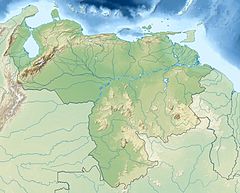Anomaloglossus tamacuarensis
| Anomaloglossus tamacuarensis | |
|---|---|
| Scientific classification | |
| Domain: | Eukaryota |
| Kingdom: | Animalia |
| Phylum: | Chordata |
| Class: | Amphibia |
| Order: | Anura |
| Family: | Aromobatidae |
| Genus: | Anomaloglossus |
| Species: | A. tamacuarensis
|
| Binomial name | |
| Anomaloglossus tamacuarensis | |
| Synonyms[3] | |
|
Colostethus tamacuarensis Myers and Donnelly, 1997[2] | |
Anomaloglossus tamacuarensis is a species of frog in the family Aromobatidae. It is found in the Sierra Tapirapecó in the Amazonas state of Venezuela as well as in the adjacent Amazonas state of Brazil (where the range is known as Serra do Tapirapecó).[3][4]
Etymology
[edit]The specific name tamacuarensis refers to the type locality, Pico Tamacuari in the Sierra Tapirapecó.[2]
Description
[edit]The type series consists of two adult males, two adult females, and four juveniles. The males measure 21.4 and 22.4 mm (0.84 and 0.88 in), the females 24.8 and 25 mm (0.98 and 0.98 in), and the juveniles 16.9–20 mm (0.67–0.79 in) in snout–vent length. The head is little wider than it is long. The tympanum is inconspicuous. The fingers have fringes but no webbing; the toes are moderately webbed. The dorsum is brown to yellowish brown with darker brown markings; dorsal skin is granular. There is a poorly defined, pale oblique lateral line. Males have gray throat, white-stippled chin, and pale dirty green or yellowish venter, where females have pale gray or silvery white throats and silvery white venters.[2]
Anomaloglossus tamacuarensis resembles Anomaloglossus shrevei from the Duida-Marahuaca Massif.[2]
Habitat and conservation
[edit]Anomaloglossus tamacuarensis is found in or near rocky forest streams. The Venezuelan type locality is at an elevation of about 1,160–1,200 m (3,810–3,940 ft) above sea level, whereas the Brazilian record is from 350 m (1,150 ft) asl.[1][4] It is active both day and night.[4] Males call from beneath large boulders. Not much information is known about this species but flash flooding is thought to threaten it as the flooding occurs in its habitat. The species is protected by the Parima Tapirapecó National Park in Venezuela.[1]
References
[edit]- ^ a b c Enrique La Marca, Celsa Señaris (2004). "Anomaloglossus tamacuarensis". IUCN Red List of Threatened Species. 2004: e.T55156A11262241. doi:10.2305/IUCN.UK.2004.RLTS.T55156A11262241.en. Retrieved 16 November 2021.
- ^ a b c d Myers, C. W.; Donnelly, M. A. (1997). "A tepui herpetofauna on a granitic mountain (Tamacuari) in the borderland between Venezuela and Brazil: Report from the Phipps Tapirapecó Expedition". American Museum Novitates (3213): 1–71. hdl:2246/3610.
- ^ a b Frost, Darrel R. (2017). "Anomaloglossus tamacuarensis (Myers and Donnelly, 1997)". Amphibian Species of the World: an Online Reference. Version 6.0. American Museum of Natural History. Retrieved 3 May 2017.
- ^ a b c Caramaschi, U.; de Niemeyer, H. (2005). "Geographic distribution: Colostethus tamacuarensis" (PDF). Herpetological Review. 36: 73.


